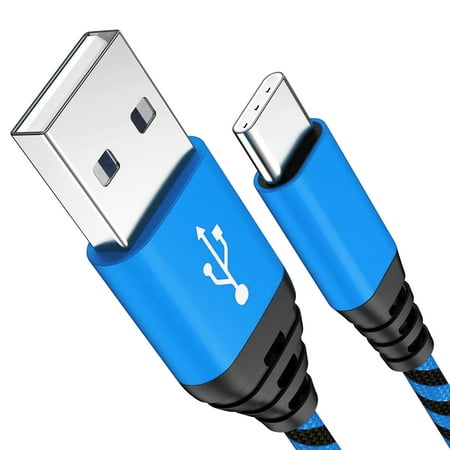6FT USB Type C Cable Fast Charging Cable USB-C Type-C 3.1 Data Sync Charger Cable Cord For Samsung Galaxy S10 S10e S9 S9+ Galaxy S8 S8 Plus Nexus 5X 6P OnePlus 2 3 LG G5 G6 V20 HTC M10 Google Pixel XL
Description? High-pace rate & sync, Charges up faster than standard cables and transfers data at 480Mbps via USB 2.0, imparting a much faster charging and data trade than other generally cables? High hardness anti scratch steel plating connector and robust nylon fiber jacket provides the sturdiness of the cable, clean to the coil to preserve your usb cables managed? Lightweight for easy delivery and durable sufficient to face the check of time? Reversible Connector: With 56k Ohm Pull-up Resistor, smaller, smarter and more handy!? USB-C’s (TYPE-C) consumer-pleasant design simplifies the connection? Plug and unplug easily without checking for the connector orientation, lets you insert the connector the right manner whenever? The cable is a first rate safe way to rate and facts sync your new USB Type-C devices. It is completely based totally on the Type-C USB three.1 tool to designProduct Features? Length: 6 Feet? Feature: Nylon Braided? Connector 1: USB 3.1 kind-C Male? Connector 2: USB 2.0 kind-A Male? Cord Rating: 28AWG(Data Sync) & 21AWG(Power)Compatible with:? Blackberry KEYone? Samsung Galaxy S10/S10E/S10+ 5G? Samsung Galaxy Note8 Note9 Note10 Note10+ 5G? Samsung Galaxy S9/S9 Plus? Samsung Galaxy S8/S8 Plus? Samsung Galaxy C7/C9 pro? LG G6/G5/G5 SE/V20/V30? Moto Z/Z Play/Z Force? Oneplus 2/three/3T/five? Huawei P10/P10 Plus/P9/Mate 9/Mate nine Pro/Nova/Nova Plus? ZTE ZMax Pro? ASUS ZenFone 3? Xiaomi 6? HTC 10/U11? Google Nexus 6P/5X? Google Pixel/Pixel XL? Meizu Pro five/6? ZUK Z2 Pro? Nintendo Switch? And greater with Type-C devices? Super fast charging time and excessive-velocity transmission? Durable Nylon Braided Quality Charging Cable? Special reversible USB-C person-pleasant design


![For Samsung Galaxy S8 S9 S10 Plus Note 8 9 Adaptive Fast Charger Type-C USB Cable Kit! [1 Home Charger + Type-C USB Cable] Adaptive Fast Charging uses dual voltages for up to 50% faster-charging Black For Samsung Galaxy S8 S9 S10 Plus Note 8 9 Adaptive Fast Charger Type-C USB Cable Kit! [1 Home Charger + Type-C USB Cable] Adaptive Fast Charging uses dual voltages for up to 50% faster-charging Black](https://i5.walmartimages.com/asr/19a0add2-c7f3-4059-9aac-1c7bb0bc8d56_1.117e210b7945ef007cdbe9bcf0ff5893.gif?odnHeight=450&odnWidth=450&odnBg=ffffff)








Reviews
There are no reviews yet.